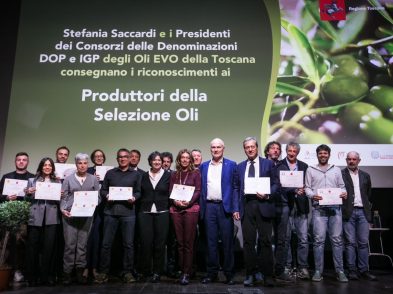With autumn truly upon us and the colours in the
fields and markets changing, so are the flavours of our table. Now that the wine
harvest is done and while the olive groves await harvest, it’s time to store
some of our autumn harvest-as well as eat some.
One of Tuscany’s greatest autumn harvest dishes is ribollita,
made of bread, beans and vegetables. Tuscans are known all over Italy as mangiafagioli (bean-eaters). They do not have a rich culinary history in their pasta dishes
for primi piatti (first courses). Instead, the history of their primi
piatti lies in beans, dried legumes and bread soups such as ribollita.
It is believed the origins of ribollita,
meaning simply ‘reboiled,’ date back to the Middle Ages and the heart of the
Tuscan countryside. Under the feudal system, in the grandest country estates in
Tuscany, at the end of a banquet, the hungry, hard-working peasants who served
table to the lords and ladies of the manor, would pocket the leftover crusts
and crumbs of Tuscan bread after their masters’ abundant feasts. But before
tucking the bits of bread into an apron pocket, under a skirt, or down a
blouse-front, they would wipe the plates clean of the leftover meat juices to
allow the dense, unsalted bread to soak up these precious flavour-filled
juices.
Back at their humble homes on the estate, the crusts
and crumbs of bread, soaked with the fragrant meat juices from such delicacies
as piccione (roast pigeon), daino (deer) or cinghiale (wild
boar) sauce, would not be eaten immediately but instead set aside for further
preparation. The anticipation of these folk with little in their stomachs can
only be imagined.
Cannellini beans would be soaked in water, then put to
rest by the side of the fire in a fiasco (a glass bottle), containing
water, rosemary, garlic and olive oil, and left to cook very slowly overnight.
The next day, the vegetables growing in the peasants’ small patches of earth
allowed for personal use on the estate would be harvested, scrubbed clean of
dirt, rough-chopped into nice chunks and added to the pot: late carrots, an
onion or two, a few leaves of cavolo nero (relative of the common
cabbage) and anything else edible growing in the garden. The final, and
probably most important, ingredient in this simple yet wonderful Tuscan dish is
the deluge of extra-virgin olive oil poured raw onto every portion prior to
serving.
With my growing passion for all things pig, I have
been roasting pork belly ever more frequently, so my recipe for the famous
Tuscan ribollita starts by dipping the bread into the roasting pan after
the pork belly comes out, soaking up the caramelized salty pork flavours from
the bottom of the pan before adding the now very tasty and seasoned bread to
the recipe, following the tradition born in the Tuscan countryside centuries
ago. Buon appetito!
RECIPE
Rachel’s Ribollita Serves 4 as a piatto unico
INGREDIENTS
For
the bread:
Pane
raffermo (day-old Tuscan bread)
Juices
from a roasting tray after the roast has be removed, especially pork belly
juices and caramelized crunchy bits that stick to the bottom of the roasting
pan, plus half a glass of Chianti Classico.
Take
the roasting pan with all the delicious caramelized bits on the bottom and heat
up the tray over a gas flame. Once hot, add the half glass of Chianti Classico,
let reduce, turn off the flame. Dip the bread into the wine-soaked pan to soak
up all the flavours. Set aside.
For
the beans:
1
large cup of dried cannellini beans
3
cloves garlic
1
sprig of fresh rosemary
Fresh
sage leaves
Extra
virgin olive oil
Soak
the beans overnight in water, rinse off, cover with fresh cold water and bring
to boil. Add the peeled garlic cloves, sage and rosemary, olive oil and salt,
and let simmer for about 60 minutes until tender. Leave to rest in the cooking
water until needed.
Vegetables:
3
small carrots
2
red onions
4
ripe tomatoes
1
huge handful of young, sweet cavolo nero leaves
PREPARATION
Wash,
peel and roughly chop the vegetables; sauté the onion, leaving to cook slowly
without browning in olive oil for about 10 minutes. Then add the carrots,
roughly diced, followed by the cavolo nero leaves, ripped roughly by
hand and thrown into the pot. Sweat the onions, carrots and cavolo nero with the onions in the olive oil until the green of the cavalo nero becomes brighter. Add the tomatoes cut into large pieces, a generous cup of
water, salt and pepper and let simmer about 15-20 minutes until all the
vegetables become tender.
Add
to this the cannellini beans with half of their cooking water. Simmer again
with the vegetables for another 15-20 minutes. Taste for seasoning and texture,
making sure the carrot, cavolo nero and beans are around the same
tenderness. When ready, add the bread with the rest of the cooking water from
the beans. Cook for 5 minutes, then let rest overnight.
The
next day, heat up the mixture, adding more water if necessary, and finish off
with lashings of extra-virgin olive oil. The best way to eat this is served
warm, not boiling hot, so that all the flavours show themselves.
WINE
MATCH
The
best wine to serve with this version of ribollita is the rest of the
Chianti Classico you used to pour into the roasting pan after you took the pork
out!







